1. The 26 Basis Point Move in 10 Year Treasury Yields Since Sept. 14th Represents a 1.4 Standard Deviation Event…Watch for 2 Standard Deviation Event
Marketwatch-The sharp rise in interest rates over the last two weeks appears to be the main culprit. According to Goldman Sachs, the 26 basis points rise in the 10-year Treasury yield since Sept. 14 represented a 1.4 standard deviation event, and the 20 basis point rise in the 10-year TIPS yield represents a 1.7 standard deviation event.
Since 1965, they note, stocks struggle when rates rise by two or more standard deviations. With the long-duration information technology and communication services sector now accounting for 40% of the S&P 500 market cap, the index is even more sensitive to rate shocks.
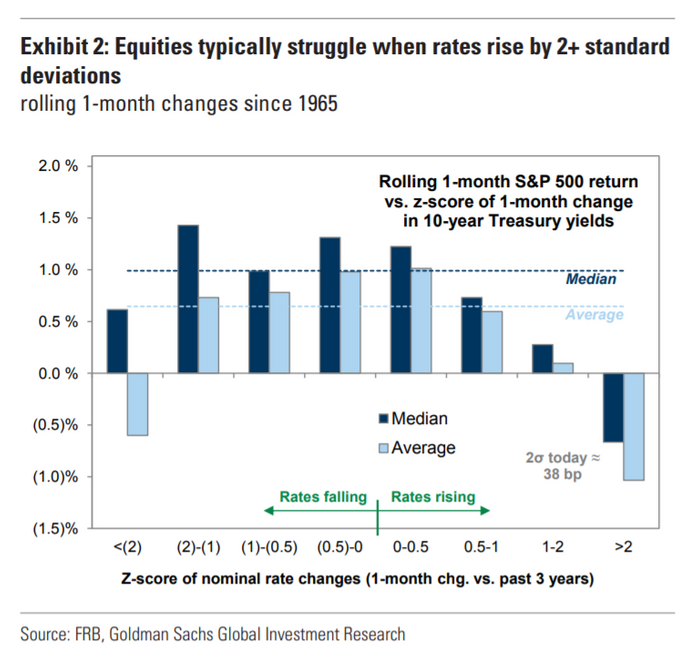
B
2. 60/40 Portfolio Struggling with Rate Rise…-97bps in September

From Dave Lutz at Jones Trading. Battered 60/40 Strategy Followers Face More Pain as Yields Rise – The traditional U.S. asset mix of 60% stocks and 40% fixed-income securities was down about 97 basis points in September as of Friday, according to Bloomberg. That’s the biggest monthly loss since October
3. Bloomberg Now Estimating 90m Empty Apartments in China.
A Nation of Empty Apartments
There are enough empty apartments in China to house an estimated 90 million people
Sources: Financial Times, United Nations
If you’re a New Zealander or Canadian or American, you might think your housing market is wild. And it is. But for sheer deadly froth, nothing matches China. Not only have prices been soaring, but real estate makes up nearly 30% of GDP, compared with 19% for the U.S. in its housing bubble, writes Noah Smith. Worse, housing makes up 78% of Chinese assets, compared with 35% for the U.S., writes Niall Ferguson. Popping this bubble would hammer China’s economy in a way that could make the Great Recession look like a spoiled gender-reveal party.
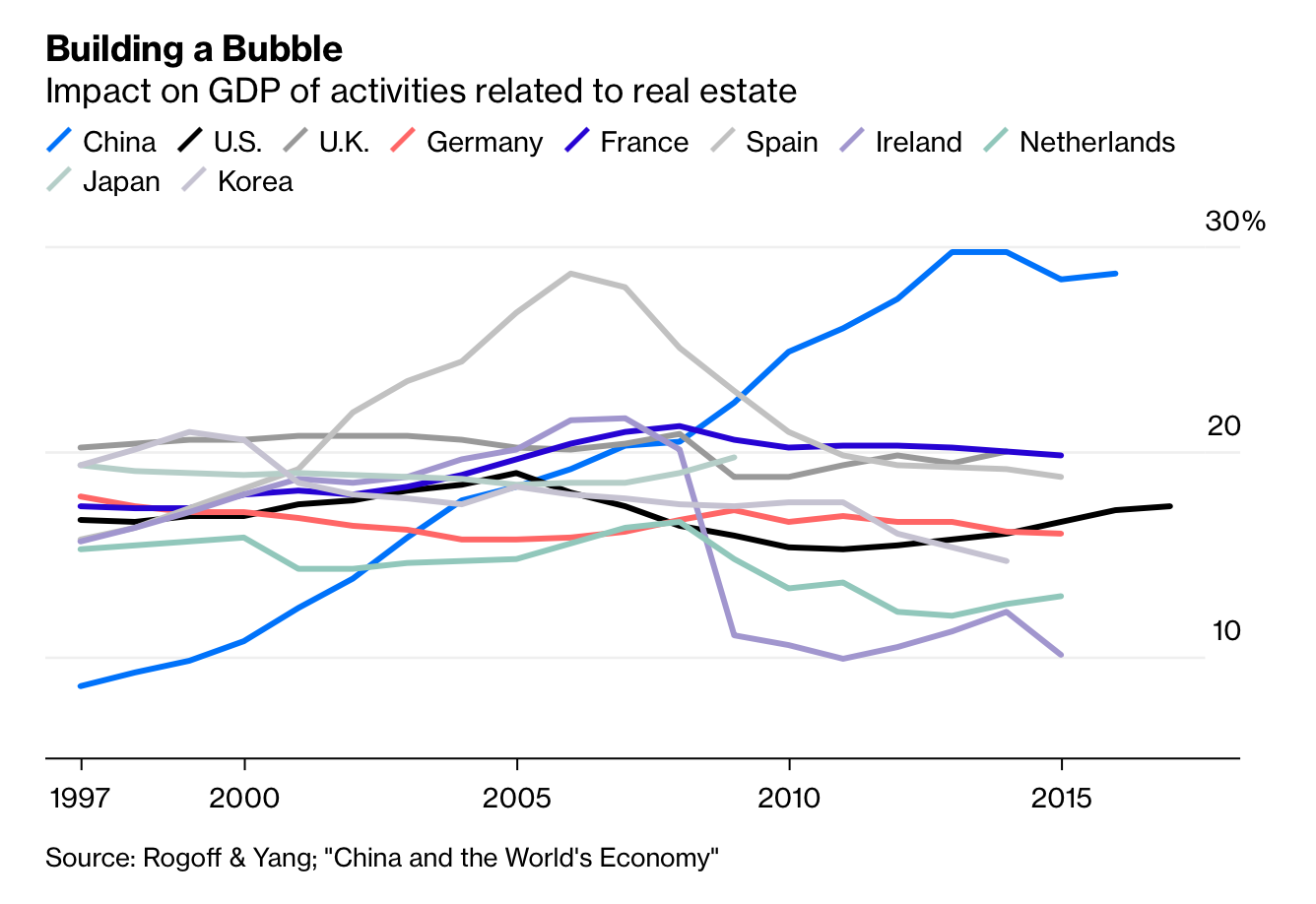
https://www.bloomberg.com/opinion/articles/2021-09-27/china-s-housing-bubble-is-the-real-backdrop-for-evergrande?sref=GGda9y2L
4. China—The Property Market is Probably Largest Global Asset
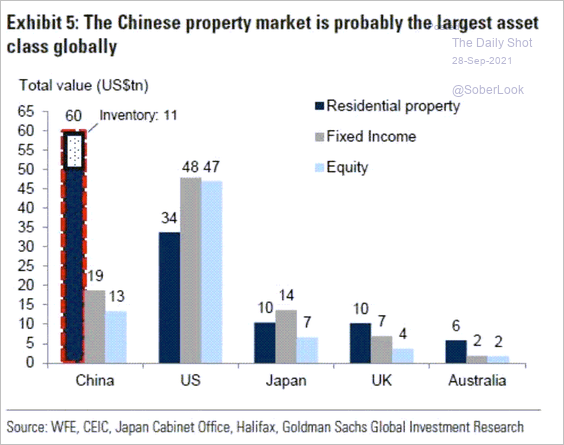
The Daily Shot https://dailyshotbrief.com/
5. What is behind China’s power crunch?
Shivani Singh and David Stanway
BEIJING (Reuters) – China is in the grip of a power crunch as coal supply shortages combined with strong power demand from manufacturers, industry and households push coal prices to record highs and trigger widespread curbs on usage.
Climate watchers have been at pains to say Beijing’s tougher environmental curbs are not to blame for the current energy crunch. Indeed, China has focused on cutting power consumption, not coal output.
Instead, China’s heavily controlled power pricing system prevents its generators from passing on their soaring coal costs to consumers, leaving them with no choice but to suffer losses or reduce output.
https://finance.yahoo.com/news/explainer-behind-chinas-power-crunch-081434452.html’
More Than Half China’s Power Still Comes from Coal
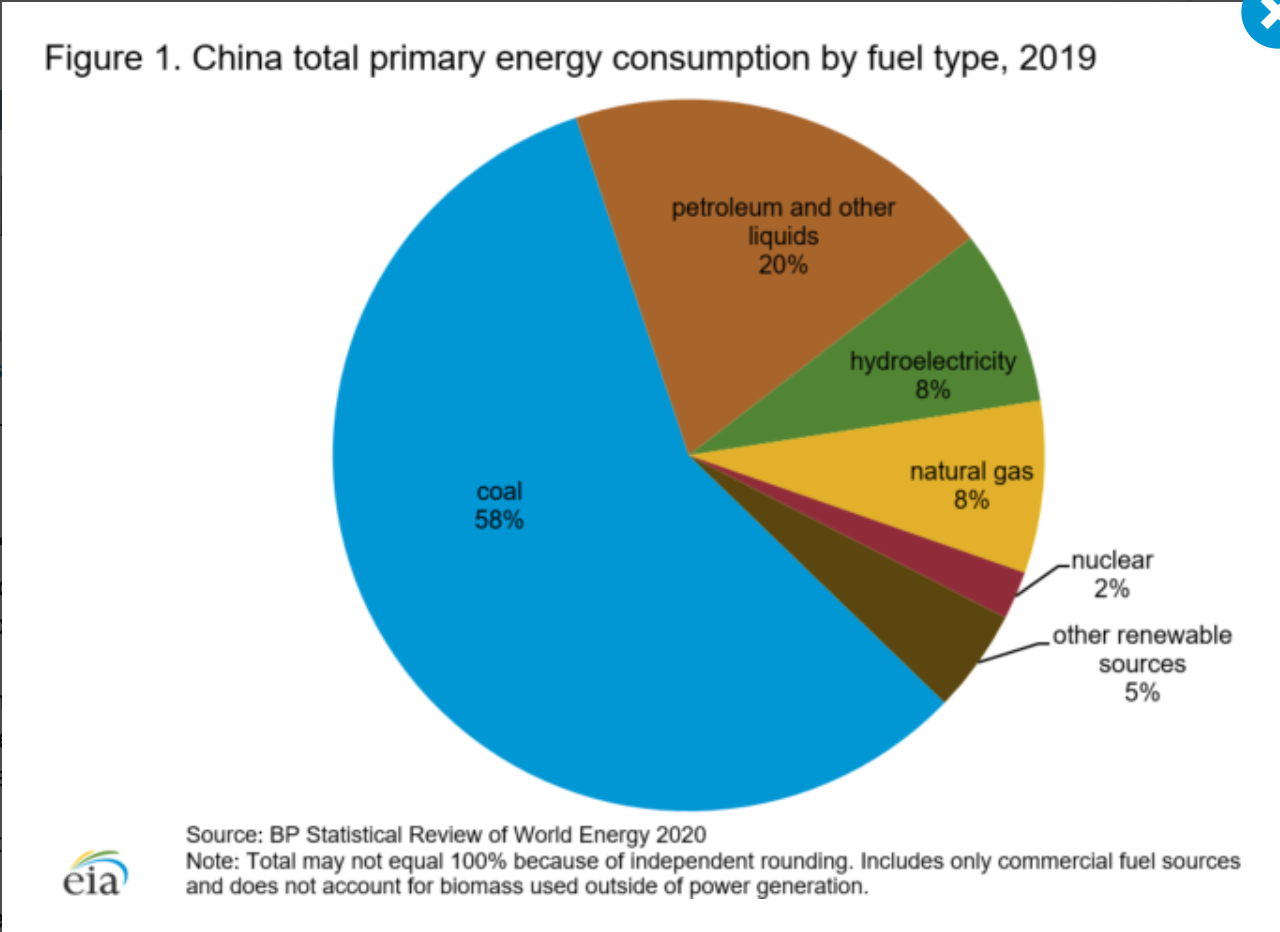
https://www.eia.gov/international/analysis/country/CHN
6. Everyone’s Favorite Chart to Watch During Pullbacks….ARKK -30% from 2021 Highs.
More Important….See Series of Lower Highs on Chart.
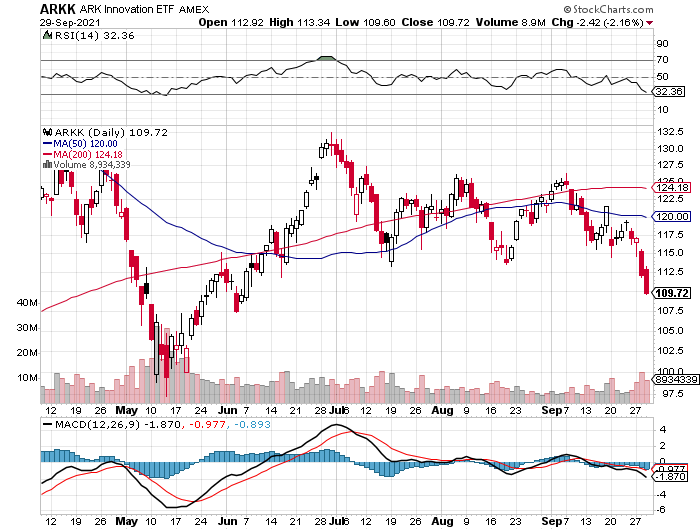
7. Jim Reid Deutsch Bank Chart—ECB Consistently Tightens Based on Oil Prices.
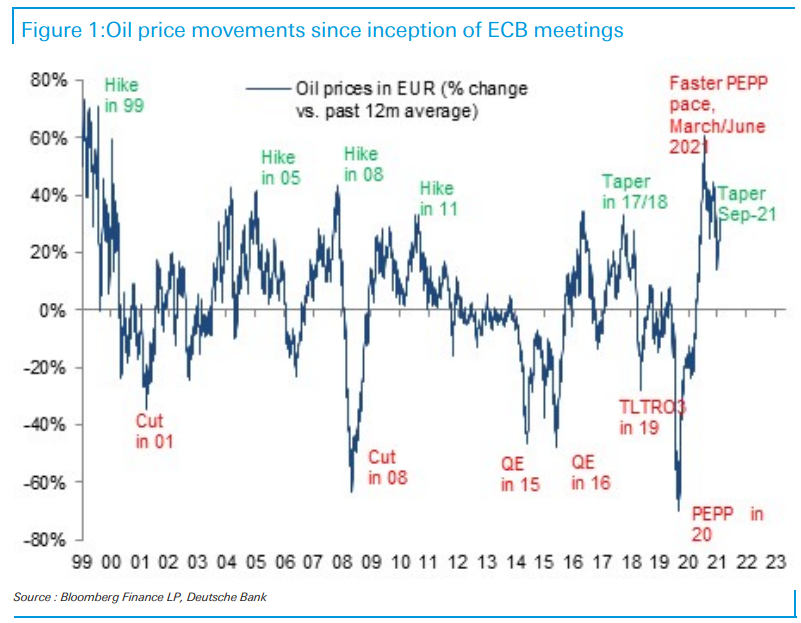
The financial world is trying to work out what the implications are for the energy price shocks we are seeing and whether central banks should tighten policy as a result or keep policy loose to reflect possible demand destruction that it might eventually bring. Indeed yesterday ECB President Lagarde warned that the “key challenge is to ensure that we do not overreact to transitory supply shocks that have no bearing on the medium-term”.
However, this has not been how they traditionally respond to big energy moves. Today’s CoTD (with a hat tip to DB’s Francis Yared) shows that since the ECB came into being they’ve tended to consistently tighten into rising oil prices (green on the graph) and loosen when they notably fall (red). The exception was in March/June this year when they loosened further by increasing the pace of the PEPP.
So it’s interesting that in a world where central banks and markets tend to focus on core inflation rather than headline, the ECB’s monetary policy has been very linked to the ebb and flow of oil prices over the last 20 plus years.
Francis Yared updated DB’s yield forecasts a couple of weeks ago (link here). He saw US 10yr at 1.80% by YE21 and 2.40% by H1 2022. For 10yr Bunds he saw -0.1% by YE21 and 0.25% by H122. He believes the decision to extend PEPP into March and June may have been a factor helping the extreme summer rally in global rates. As they have now started to reverse that, alongside more hawkish moves from other central banks, it perhaps helps explain why we are in a rising bond yield environment for now.
Jim Reid Deutsche Bank
8. 20 Fastest Growing Jobs: 2020-2030
September 28, 2021 11:00am by Barry Ritholtz20 Fastest Growing Jobs: 2020-2030

Found at Barry Riholtz Blog 20 Fastest Growing Jobs: 2020-2030. https://ritholtz.com
9. The 5 best vegan protein powders that actually taste good
When you buy through our links, Insider may earn an affiliate commission. Learn more.
- Supplementing with plant-based protein powder is a healthy way to reach your daily protein goals.
- Vegan protein powder builds muscle and supports recovery just as well as whey or dairy proteins.
- The best vegan protein powder should taste good, mix well, and have a simple ingredient list.
- This article was medically reviewed by Erika Villalobos-Morsink, RD, a dietitian based in New York City.
More and more people are cutting animal products where they can for their health and the environment. For fitness buffs or folks who like to add a little protein boost to their smoothies, that means switching over from a dairy-based protein like whey or casein to plant-based proteins.
Studies show plant-based proteins are actually pretty comparable to whey or casein when it comes to helping you build muscle. But, like all supplements, it’s important to pick a vegan protein powder that’s derived from high-quality ingredients; has a clean, unadulterated formula; and, of course, that tastes good.
Here are the best vegan protein powders:
- Best vegan protein powder overall: TB12 Plant-Based Protein
- Best tasting vegan protein powder: Aloha Organic Protein Powder
- Best vegan protein powder for training athletes: Vega Sport Protein Powder Premium
- Best vegan protein powder for meal replacement: Garden of Life Raw Organic Meal
- Best vegan protein powder for weight loss: Isopure Plant-Based Protein
The best vegan protein powder overall
Though it’s a little pricey, TB12 Plant-Based Protein tastes great, mixes well, is sugar-free, and offers a great macronutrient profile with plenty of protein.
Pros: Great taste, high protein, low carb/fat formula, packed with BCAAs, single ingredient list
Cons: Expensive, flavored varieties contains some additives
Protein type: Pea protein
Consumer Lab approved? N/A
Grams of protein per serving: 24g
Total carbohydrates: 20g
Total sugars: 0g
Total calories: 110
Tom Brady’s diet has become sporting folklore and launched an entire brand: The TB12 Method. This includes a TB12, which is not only our top overall pick but also the best pea protein powder.
For starters, this plant-based protein powder is tasty, even with just water, which is a very important factor if you’re going to be drinking protein powder daily. Also, the macronutrient profile of this one is solid with one scoop of this powder delivering 110 calories, 20 grams of protein, 2 grams of carbs, 2 grams of fat, and 0 grams of added sugar. It also contains all of the essential branch chain amino acids, which are essentially the building blocks of protein, to help your body recover and form muscle.
We also love that the unflavored option has only one ingredient: pea protein.
Note that while the chocolate and vanilla both taste delicious, they do contain the additives of guar gum (for texture) and natural sweeteners of stevia and monk fruit. Our nutritionists say these aren’t unhealthy, perse, but can cause digestive issues for some people. A healthier option is to use the single-ingredient unflavored variety and add your own cocoa powder at home.
The best tasting vegan protein powder
Though it’s lower in protein and higher in carbs, Aloha Organic Protein Powder is the best-tasting vegan protein powder we’ve found.
Pros: Tastes amazing, clean ingredient profile, organic plant-based protein powder
Cons: Expensive, low in protein, high in carbs, only 15 servings per tub
Protein type: Pea, brown rice, pumpkin seed, hemp seed
Consumer Lab approved? N/A
Grams of protein per serving: 18g
Total carbohydrates: 6g
Total sugars: 4g
Total calories: 130
Once you’ve choked down enough protein powders, like I did for testing this article, you start to really value formulas that taste good. When I tried the Aloha Organic Protein Powder, I actually let out an audible “Wow, that’s good.”
It was more complex than just chocolate, with the flavors of nutmeg, cinnamon, and cocoa. I drank this on its own and tried it mixed with oatmeal, both of which were great.
The downside for some may be that this protein powder not only requires two scoops for the serving size, but that amount packs only 18 grams of protein and 11 grams of carbs, which is on the high end for most protein powders.
Still, the nutritional profile is great. We love that this is a certified organic plant-based protein powder. And you can pronounce every ingredient that’s in this powder, and it’s free of GMOs, dairy, gluten, and sugar alcohols (which can cause stomach distress). The protein is a blend of hemp, pea, brown rice, and pumpkin seed protein, which studies show makes for the best essential amino acid profile.
The real issue is the cost: For $30 (or $27 if you subscribe and save), you only get 15 servings, which comes out to $2 per serving. That’s expensive if you use protein powder regularly. Still, this is a great option if you’re just looking to supplement some of the time.
The best vegan protein powder for athletes
Vega Sport Protein Powder Premium offers a high-protein blend, tastes great, has a full BCAA profile, and is NSF certified.
Pros: Higher protein content, tastes great, smooth texture, third-party tested
Cons: Expensive
Protein type: Pea, pumpkin seed, organic sunflower seed, and alfalfa
Consumer Lab approved? Yes
Grams of protein per serving: 30g
Total carbohydrates: 4g
Total sugars: 2g
Total calories: 160
With 30 grams of protein per serving and a complete BCAA profile, Vega Sport protein powder is formulated to help athletes and active folks recover from tough workouts. When I tested, it tasted great and gave me the protein I needed to hit my 200-gram daily goal.
The ingredients are premium, too. The protein blend is made up of four sources — pea, pumpkin seed, organic sunflower seed, and alfalfa protein — and it contains ingredients such as tart cherries to potentially aid recovery and probiotics for enhanced gut health.
When I followed the instructions to combine the powder with 12 oz water or milk, I found this protein to be a little too watery for my liking. Of course, you can add less water, but even then, it didn’t have the same frothy and creamy texture of the TB12 or Aloha protein.
However, we love that Vega Sport protein powder is NSF certified, meaning it’s independently tested for quality and safety. This way, you know the company is confident in its product and you’re not ingesting any BS fillers or dangerous chemicals.
$39.99 FROM AMAZON$34.99 FROM
The best vegan protein powder for a meal replacement
Garden of Life’s Raw Organic Meal is a hearty meal replacement powder that offers 20g of protein per serving, is made with peas, sprouts, and legumes, and packs probiotics for improved digestion.
Pros: Consumer Lab-certified meal replacement powder, high protein offering, diverse protein source, low in sugar, inexpensive, probiotics, certified organic plant-based protein powder.
Cons: Only 130 calories per serving, not the best flavor
Protein type: Pea, sprouted brown rice, amaranth, buckwheat, millet, quinoa, chia seed, garbanzo bean, lentil, adzuki bean, flax seed, sunflower seed, pumpkin seed, sesame seed
Consumer Lab approved? Yes
Grams of protein per serving: 20g
Total carbohydrates: 10g
Total sugars: < 1g
Total calories: 130
If you’re looking for a vegan protein powder to have in lieu of a meal replacement, we love Garden of Life’s Raw Organic Meal as it’s certified by Consumer Labs to have a safe and accurate formula and packs 20g of protein per serving.
The only catch is one scoop is just 130 calories, which is less than half of what a healthy meal should deliver. However, you can use this powder in a smoothie or combine with a higher-calorie oat milk to beef up the energy delivery.
The organic, plant-based protein powder delivers 1.5 billion CFU of live probiotics and 13 digestive enzymes, has 5g of fiber per serving, and less than 1g of sugar per scoop. The vegan protein is also derived from over a dozen different plant-based sources like pea, sprouted brown rice, and quinoa, which helps diversify its nutritional offering.
Garden of Life offers its organic plant-based protein powder in either chocolate, vanilla, lightly sweet, or vanilla chai and while the flavors aren’t terrible, they do leave a little to be desired — all the more reason to use the powder in a smoothie.
The best vegan protein powder for weight loss
Isopure Plant-Based Protein gives you 110 calories and 20 grams of protein and is relatively cost-effective.
Pros: Low-calorie, tasty flavor offerings
Cons: Small tub, few flavors to choose from, expensive per 20g of protein
Protein type: Organic pea and brown rice
Consumer Lab approved? N/A
Grams of protein per serving: 20g
Total carbohydrates: 2g
Total sugars: og
Total calories: 110
Isopure’s Plant-Based Protein stands out due to its taste and texture but also that it offers 20 grams of vegan protein at just over 100 calories. For bodybuilders or folks who follow a strict calorie diet, this means you’re not ingesting unwanted fat, carbs, or calories.
I also like that Ispoure’s organic pea and brown rice protein combo is easy on the stomach. It’s one of the cheapest powders on our list, too.
My only major gripe with this powder is that you only get 20 servings in one canister, which means some people will need to restock twice a month. It comes in just four flavors — chocolate, vanilla, strawberry, and unflavored — which is fine if you typically add your protein to a smoothie but can get dull if you’re a water-and-blender-bottle type person like me.
https://www.businessinsider.
10. 5 Habits of Mind That Tend to Make Life Harder
A few unskillful reactions to life’s inevitable challenges.
KEY POINTS
- Buddhist philosophy describes five unskillful ways to react to life’s disappointments and challenges, which can become habits of mind.
- Hindrances include seeking solace in sensual pleasure, getting angry, becoming apathetic, worrying and doubting oneself.
- With mindfulness and self-compassion, people can find a more skillful way to respond when life doesn’t go their way.
Not a day goes by without encountering some disappointment or frustration.
A minor example: You just put the pen down and now can’t find it.
A less than minor example: Your computer crashes.
A major example: Due to poor health, you can’t travel to meet a new grandchild.
The five hindrances
In Buddhist philosophy, there are five unskillful reactions to life’s challenges. They’re called hindrances because they hinder your ability to see clearly how to act so as not to make things worse for yourself or others. Whenever you’re feeling stressed and uneasy, it’s usually because you’re caught in the web of one or more of these hindrances. They often become habits of mind, meaning that each time you react in one of these five ways, the hindrance gets stronger and you’re more likely to react that way in the future.
I’m going to use a computer crashing as an example of the hindrances in action. Here are five ways you might respond to this unwelcome event.
1. Seeking solace in sensual pleasure
This hindrance refers to any sensual pleasure you engage in under the mistaken belief it will make you happy by allowing you to forget your difficulties. And so, you avoid your computer problem by turning to something pleasurable, such as eating ice cream or putting on re-runs of your favorite TV show. There’s absolutely nothing wrong with enjoying yourself in these ways. They only become a problem when this behavior results in avoiding something that needs attending to, in this case, your computer.
2. Getting angry
Anger arises when you believe that people or things should be other than they are. You feel as if the world is treating you unfairly because your computer should not be giving you trouble. But computers do at times, no matter what your IQ. Anger ranges from mild irritation to becoming so enraged that you throw your computer at the wall, thereby assuring that it will stay “crashed.”
3. Becoming apathetic
This hindrance is often referred to as torpor or lethargy. You tell yourself that it’s too much effort to deal with a computer that’s not working. This hindrance is another way of avoiding what you know you need to do. And so, you say to yourself, “Forget it; I’m just going back to bed.” Unfortunately, when you get up, your computer will still be “asleep.”
4. Feeling uneasy and worrying
This hindrance includes the tendency to spin worst-case scenarios, even though you don’t have the facts to back any of them up: “My computer is unfixable”; “I’ll never recover my data”; “My partner will call me incompetent because my computer crashed.”
It’s unlikely that worst-case scenarios come to pass. Maybe all your computer requires is a reboot (I speak from personal experience here). Unfortunately, you’re so busy forecasting a future that’s full of computer doom that it never occurs to you to try any number of simple solutions.
5. Doubting yourself
This hindrance shows up as a lack of confidence in your ability to solve life’s challenges. You feel as if you’re not competent to deal with any computer issue. You blame yourself for it having crashed in the first place. This type of thinking keeps you from focusing on how you might fix your computer, something everyone has to do once in a while.
The multiple hindrance attack
You may have recognized your own reactive tendencies in one or more of these five hindrances. People tend to “specialize” in one, depending on the habits they’ve formed over their lifetimes.
It’s also not uncommon for more than one hindrance to arise in response to things not going your way. Buddhist teachers lightheartedly call this a “multiple hindrance attack.” You may be downing that ice cream to avoid fixing your computer and be angry at yourself and be worrying about what’s going to happen with it and be doubting your ability to solve any problem in life. And there you have it—four of the five hindrances working together, making you more and more miserable.
Responding skillfully to the hindrances
The first step in changing these habitual responses to things not going your way is to become aware that they’ve arisen. This is a mindfulness practice. For me, it helps to keep a list of the five hindrances in mind. Identifying which hindrance has arisen helps because it keeps it from intensifying. In fact, bringing it into conscious awareness may dissipate it altogether because, for example, you’ll see that neither anger nor worrying will get that computer fixed.
The second step is to dis-identify from the hindrance. By this I mean, you can lessen its hold over you by seeing it as a temporary visitor in your mind (although an unwelcome one), as opposed to as a permanent resident. Remind yourself that these are simply mental states that come and go as reactions to not getting your way. For example, try reframing what you’re feeling in this way: “My computer crashed and I’m angry and I’m worrying, but these reactions won’t help me fix it.”
The third step is to treat yourself kindly by acknowledging that these reactions don’t feel good. When life isn’t conforming to your desires, what is called for is self-compassion, not blame. Cultivating self-compassion tells you that you care about your suffering, and this calms your mind so you can see more clearly what steps you might take to make things better.
Not a day goes by without our experiencing some frustration over not getting our way. I call this want/don’t want mind. I want to find that pen I just put down; I don’t want my computer to crash. The fact is… life doesn’t always go the way we want it to. When this happens, it helps to recognize which of these five unskillful reactions have arisen and then to counter them with mindfulness and self-compassion.
You might also find this helpful: “Constant Complaining: Does It Serve Us Well?“
About the Author
Online:
For info on all my books, visit www.tonibernhard.com, Facebook